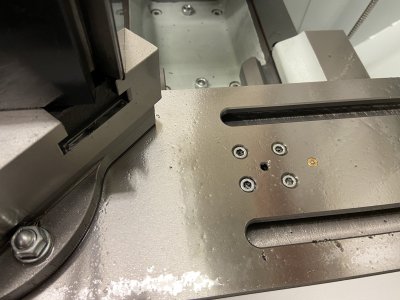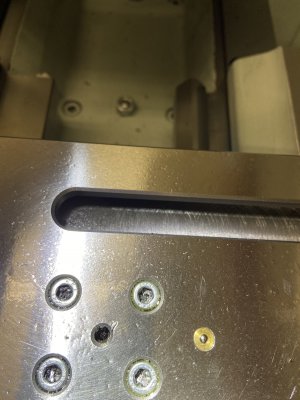The lathe, mill, and the saw were delivered at 6:00 pm on the 17th. It's just as well that they were a day later than they said, because on Monday afternoon, it rained a lot. It was getting dark so I hardly got started before it was too dark to continue. But I could see that the machine was inside a giant plastic bag. It would be ok even if it rained during the night.
Wednesday was a long day. I uncrated the 1640. It turns out that the crate was originally nailed together: but I think at PM they remove the nails at the foot of the vertical wood slats to get access to the machine, then they screw the cage back together. I removed the screws; I also removed the front panel (just had to take a look at it.) The three remaining sides and the top were then removed as a unit with two home built gantries.
Removal of four bolts (each near a leveling bolt) enabled the gantries to lift the machine a few inches, enough to slide the bottom of the crate away. The gantries are on wheels, but the weight was such that the twelve 5-inch wheels would not turn. Nor would polyurethane wheeled machine skates would not roll with the weight of the machine. Finally, success came with a 2.5-ton pallet jack. One of its wheels is about 10 inches. The gantries were left in place and came along. This was in case of a tip over, the gantries would stop a complete rollover. Safety first.
But because the parking pad and the garage floor are at about 5/8 inch slope per 10 feet, it was hard to push it into the garage. I had to use a 1x6 sacrificial board (so the painted garage floor would not be marked) and a 2x4 as a lever, wedge push stick. I could move it a few inches at a time, but the roll back (from the slope in the garage floor) would take back each gain, until I wedged the wheel as the lathe was pushed into the garage.
It was in the garage by 8:00 pm, just as it started to sprinkle.
Today I opened the second crate and started to take inventory of the small items which were shipped with the lathe.
Tomorrow, the lathe will find its long-term location; and I will put together the 728 VT mill and its base. It requires lifting the mill about 30+ inches. Gantry?
Wednesday was a long day. I uncrated the 1640. It turns out that the crate was originally nailed together: but I think at PM they remove the nails at the foot of the vertical wood slats to get access to the machine, then they screw the cage back together. I removed the screws; I also removed the front panel (just had to take a look at it.) The three remaining sides and the top were then removed as a unit with two home built gantries.
Removal of four bolts (each near a leveling bolt) enabled the gantries to lift the machine a few inches, enough to slide the bottom of the crate away. The gantries are on wheels, but the weight was such that the twelve 5-inch wheels would not turn. Nor would polyurethane wheeled machine skates would not roll with the weight of the machine. Finally, success came with a 2.5-ton pallet jack. One of its wheels is about 10 inches. The gantries were left in place and came along. This was in case of a tip over, the gantries would stop a complete rollover. Safety first.
But because the parking pad and the garage floor are at about 5/8 inch slope per 10 feet, it was hard to push it into the garage. I had to use a 1x6 sacrificial board (so the painted garage floor would not be marked) and a 2x4 as a lever, wedge push stick. I could move it a few inches at a time, but the roll back (from the slope in the garage floor) would take back each gain, until I wedged the wheel as the lathe was pushed into the garage.
It was in the garage by 8:00 pm, just as it started to sprinkle.
Today I opened the second crate and started to take inventory of the small items which were shipped with the lathe.
Tomorrow, the lathe will find its long-term location; and I will put together the 728 VT mill and its base. It requires lifting the mill about 30+ inches. Gantry?



